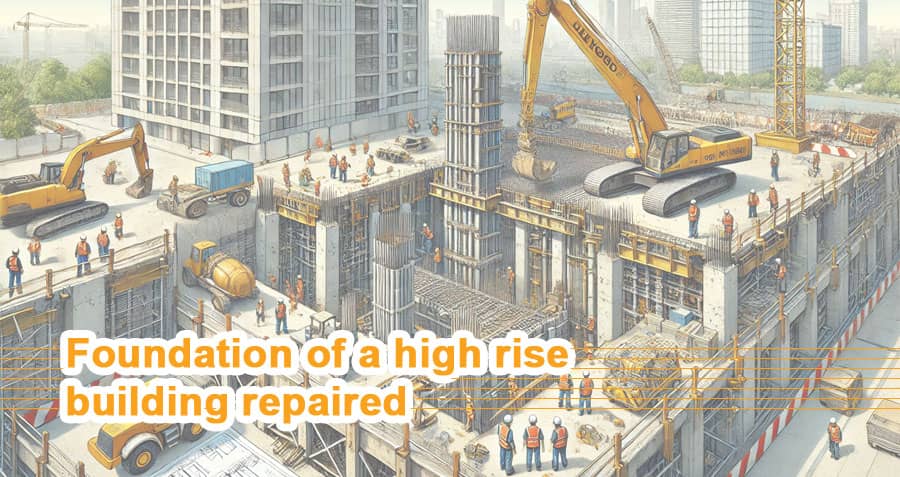How is the foundation of a high rise building repaired?

Repairing the foundation of a high-rise building is a complex and highly specialized process that requires careful planning, advanced techniques, and expertise. The foundation is critical to the structural integrity of the entire building, and repairs must be performed meticulously to avoid compromising safety. Below are the steps and methods commonly employed in foundation repair for high-rise buildings:
1. Assessment and Diagnosis
Before any repair work begins, a thorough inspection and analysis are conducted to identify the root cause of the foundation problem. This includes:
- Visual Inspections: Checking for cracks in walls, floors, or structural elements.
- Geotechnical Studies: Examining soil conditions and stability.
- Structural Analysis: Evaluating the load-bearing capacity of the foundation.
- Non-Destructive Testing (NDT): Techniques like ground-penetrating radar (GPR) or ultrasonic testing are used to assess the internal condition of the foundation.
2. Temporary Stabilization
To ensure the safety of the building and its occupants during repairs, temporary stabilization measures are implemented. This may involve:
- Shoring: Supporting the structure with temporary beams or braces.
- Load Redistribution: Reducing stress on the affected areas by transferring loads to stable sections.
3. Common Repair Methods for High-Rise Foundations
a. Underpinning
Underpinning involves strengthening the foundation by extending it to a more stable layer of soil or bedrock. Techniques include:
- Mass Concrete Underpinning: Pouring additional concrete beneath the foundation to provide extra support.
- Piled Underpinning: Installing deep foundation piles under the existing foundation to transfer loads to stable strata.
b. Jet Grouting
Jet grouting stabilizes and strengthens weak soil beneath the foundation by injecting a high-pressure mixture of water, cement, and air. This creates solidified columns of soil and cement, enhancing stability.
c. Micropiles
Micropiles are small-diameter, high-strength steel piles driven deep into the ground. They provide additional support for the foundation and are particularly useful in areas with restricted access.
d. Crack Injection
For minor issues like cracks in concrete foundations, epoxy or polyurethane resins are injected into the cracks. These materials seal the cracks and restore structural integrity.
e. Soil Stabilization
If the problem is caused by unstable soil, techniques like soil compaction, lime stabilization, or chemical grouting can improve soil strength and reduce settlement.
f. Hydraulic Jacking
Hydraulic jacks may be used to lift and level a sagging foundation. Once the foundation is realigned, voids are filled with grout to maintain stability.
4. Waterproofing and Drainage Solutions
To prevent future issues, waterproofing and drainage systems may be improved. These measures include:
- Installing Drainage Systems: Redirecting water away from the foundation.
- Waterproof Membranes: Applying protective coatings or membranes to prevent water infiltration.
- Sump Pumps: Installing pumps to remove water that accumulates near the foundation.
5. Monitoring and Maintenance
After repairs are completed, the foundation must be regularly monitored to ensure long-term stability. This involves:
- Periodic Inspections: Checking for signs of further movement or damage.
- Instrumentation: Installing sensors to monitor stress, strain, and soil movement in real-time.
Challenges in High-Rise Foundation Repairs
- Access Limitations: Working in tight urban areas or underneath an operational building.
- Load Management: Ensuring the building remains stable while repairs are underway.
- High Costs and Timeframes: Repairing high-rise foundations is often expensive and time-consuming due to the complexity and scale of the work.
Conclusion
Foundation repairs for high-rise buildings require a customized approach tailored to the specific problem and site conditions. Engaging a team of experienced structural engineers, geotechnical experts, and construction professionals is essential to ensure the success and safety of the project. Through advanced techniques such as underpinning, jet grouting, and soil stabilization, even the most challenging foundation issues can be resolved effectively.
For More information, please watch the following video tutorial
